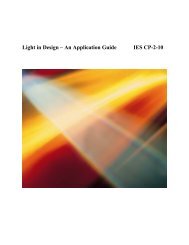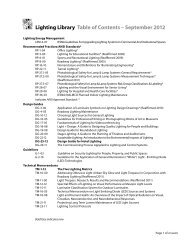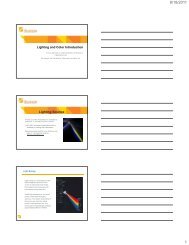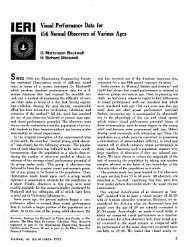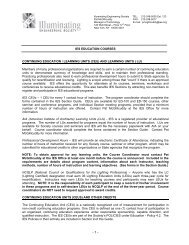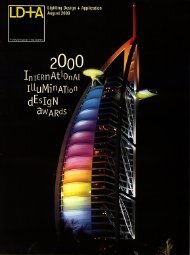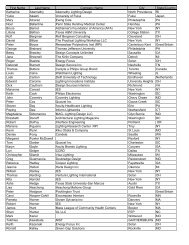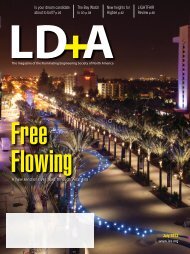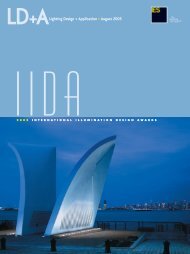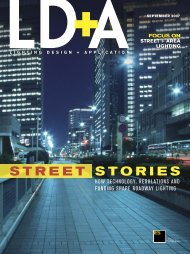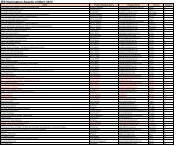faces of the future - Illuminating Engineering Society
faces of the future - Illuminating Engineering Society
faces of the future - Illuminating Engineering Society
You also want an ePaper? Increase the reach of your titles
YUMPU automatically turns print PDFs into web optimized ePapers that Google loves.
LETTERS<br />
entities that are supposed to advocate<br />
and support good design.<br />
Hopefully, our final act (as you<br />
wrote) will be a legacy <strong>of</strong> lighting<br />
for human visual needs as we know<br />
<strong>the</strong>m to be, not a bus accident.<br />
As Greg said, sustainable design<br />
begins with sustaining people.<br />
Bruce C. Dunlop, PLDA, IALD, LC<br />
Bruce Dunlop Lighting Design<br />
Lu<strong>the</strong>rville, MD<br />
The DOE Defense<br />
The October issue <strong>of</strong> LD+A contained<br />
several references to DOE’s<br />
Solid-State Lighting program,<br />
which I would like to address. First,<br />
Dawn De Grazio’s letter to <strong>the</strong><br />
DIALux<br />
> DIALux is a lighting design s<strong>of</strong>tware<br />
for calculation and visualisation <strong>of</strong> indoor<br />
and outdoor lighting, street and sports lighting.<br />
> DIALux is an all-inclusive free s<strong>of</strong>tware<br />
for import from and export to all CAD<br />
programs and for photorealistic visualisation<br />
with <strong>the</strong> integrated ray tracer.<br />
> Download at<br />
www.dialux.com<br />
editor pointed out <strong>the</strong> illuminance<br />
requirements for <strong>the</strong> Walmart<br />
Leavenworth site (“Whole Lot <strong>of</strong><br />
LEDs” June 2010) were not stated<br />
and it was <strong>the</strong>refore difficult to<br />
compare <strong>the</strong> 1000-W and 400-W<br />
PMH and LED options presented,<br />
each <strong>of</strong> which produced very different<br />
illuminance levels. Good point.<br />
The target illuminance level for <strong>the</strong><br />
front drive was 1.50 footcandles<br />
(minimum) and for <strong>the</strong> main lot it<br />
was 0.75 fc (minimum), both with a<br />
max/min target uniformity <strong>of</strong> 10:1.<br />
Second, I want to address a misunderstanding<br />
evidenced in Alvin<br />
L. Hart’s letter regarding my statement<br />
in <strong>the</strong> August 2010 issue, which<br />
read: “We hope it will be clear to Mr.<br />
“Let <strong>the</strong>re be light.”<br />
> Your benefits<br />
· full version<br />
free <strong>of</strong> charge<br />
· no registration<br />
· no follow-up costs<br />
Warren that calibrated illuminance<br />
meters <strong>of</strong> differing make/model may<br />
yield different results. . . .” Mr. Hart<br />
questioned how meters calibrated to<br />
traceable NIST standards could differ,<br />
<strong>the</strong> point <strong>of</strong> calibration being to<br />
yield comparable results. In general<br />
this is true, but meter calibration may<br />
or may not include spectral correction,<br />
cosine correction, or linearity,<br />
and <strong>the</strong>se parameters may vary substantially<br />
between different make/<br />
model illuminance meters. Some<br />
calibration labs only test for one light<br />
source, at one distance, and perpendicular<br />
to <strong>the</strong> face <strong>of</strong> <strong>the</strong> sensor. We<br />
recommend that readers check <strong>the</strong>ir<br />
calibration reports for <strong>the</strong>se details.<br />
Also please see Robert E. Levin’s<br />
seminal Photometric Connection columns<br />
in LD+A, in which he notes,<br />
“Thus, a statement <strong>of</strong> traceability in<br />
itself is meaningless” (Nov, 1982).<br />
Finally, I’d like to respond to <strong>the</strong><br />
“Energy Advisor” column, which<br />
takes as its starting point my<br />
August 13, 2010 Posting, a regular<br />
e-mail newsletter I use to communicate<br />
with <strong>the</strong> lighting and energy<br />
efficiency communities about SSL<br />
issues. Mr. Warren states, “The<br />
DOE claims that an LED is 10 times<br />
as efficient (efficacious) as an<br />
incandescent lamp. That’s true for<br />
<strong>the</strong> lamp itself, however, when you<br />
include <strong>the</strong> optical, driver and <strong>the</strong>rmal<br />
losses, LEDs are only six times<br />
as efficacious as incandescents. . .”<br />
The passage Mr. Warren references<br />
is forward-looking, not a statement<br />
about current LED integral lamp<br />
efficacy: “With <strong>the</strong> promise <strong>of</strong><br />
being 10 times more efficient than<br />
incandescent lighting, LEDs will<br />
change <strong>the</strong> way Americans light



